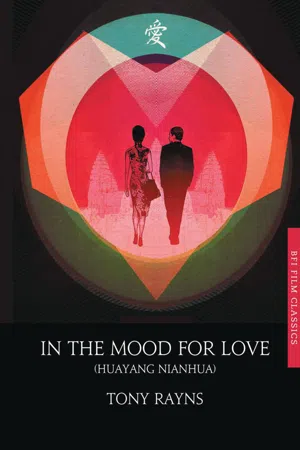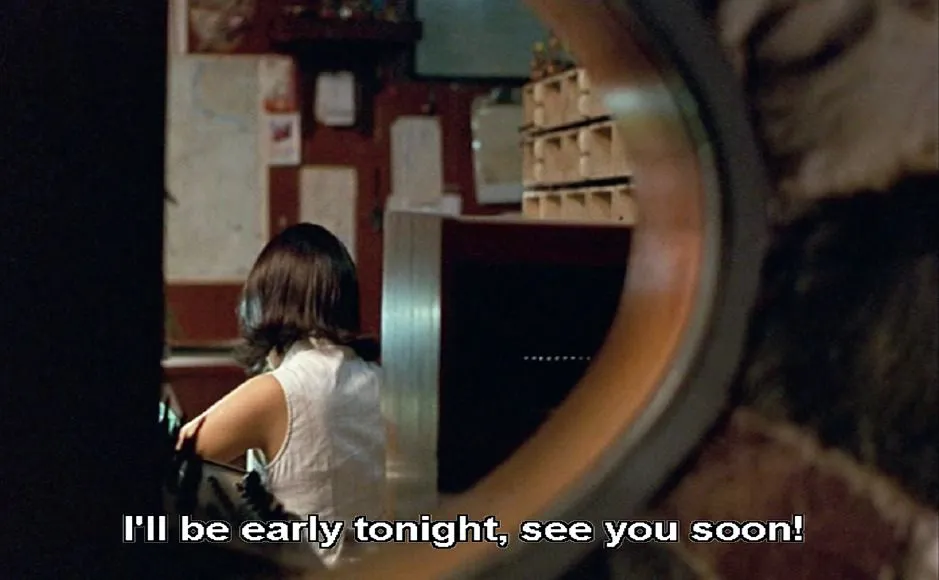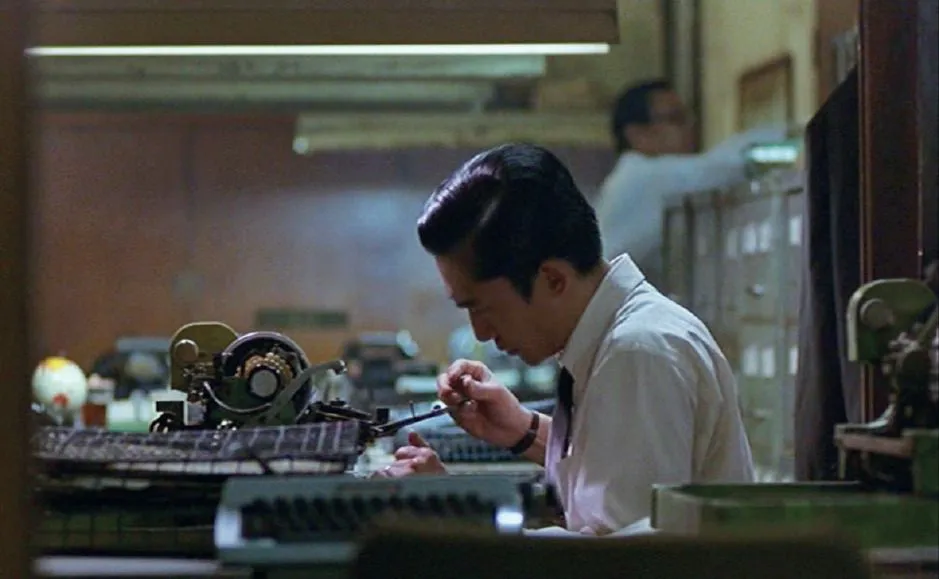![]()
1 Valse triste
From the very beginning I knew I didn’t want to make a film about an affair. That would be too boring, too predictable, and it would have only two possible endings: either they go away together or they give each other up and go back to their own lives. What interested me was the way people behave and relate to each other in the circumstances shown in this story, the way they keep secrets and share secrets.
Wong Kar Wai (19 June 2000), from an interview by Tony Rayns,
published in Sight & Sound, August 2000
We’ll come to the ‘very beginning’ in Chapter 2, but let’s start with the film itself. In the Mood for Love, set mostly in the Hong Kong of 1962, is a film that luxuriates in the feeling of being in love – without actually turning into a love story. Its two central characters, Mr Chow and Mrs Chan, are surrounded by sexual promiscuity. But when they ultimately succumb to their palpable desire for each other, they do so off screen. The film hinges on their tremulous uncertainty about their own feelings and their feelings for each other. Like David Lean/Noël Coward’s Brief Encounter (1945) several decades earlier, it’s a film about desire repressed. Worries about social appearances and gossip play a significant part in stopping the non-lovers from acting on their feelings, but Mr Chow and Mrs Chan are shown to be addicted to the manoeuvring and rehearsing – actually, the foreplay – that obviates the need to commit to an affair. They are, precisely, in the mood for love.
For most viewers, the bittersweet tone of the not-quite-sexual relationship crystallises in the haunting piece of music most often heard on the soundtrack, a valse triste (‘sad waltz’) composed by the Japanese musician Umebayashi Shigeru. This piece is called ‘Yumeji’s Theme’, because it was written originally for the film Yumeji (1991), the final part of Suzuki Seijun’s Taisho Trilogy, so called because all three films are set in the Taisho period (1912–26), the fifteen-year bridge between the Meiji and Showa periods. Meiji saw the restoration of imperial rule in Japan, and the opening-up and modernisation of the country after centuries of feudal isolation under the shoguns; Showa saw Japan turn militarist, invade China and attack the USA as it prosecuted the Pacific War. The short-lived Taisho period had much in common with Edwardian Britain and Weimar Germany. Taisho is now fondly remembered as a time of hedonism and the rise of an ero-guro culture – the term is shorthand for ‘erotic-grotesque-nonsensical’ – rooted in the pulp fiction of the day and perpetuated in, for example, Ozu Yasujiro’s student comedies and thrillers of the late 1920s and early 30s. All three films in Suzuki’s trilogy are ghost stories of a sort, exploring the era’s cultural confusions and its sexual perversity and licence.
In a glass darkly: Chow consoles Mrs Chan in room 2046
In the Mood for Love is not a ghost story, but Wong Kar Wai evidently heard something in the yearning ‘Yumeji’s Theme’ that matched his sense of the vanished manners and morals of Hong Kong in the early 1960s. He uses Umebayashi’s cue no fewer than nine times in his film – that is, even more insistently than he used The Mamas and the Papas’ ‘California Dreamin’’ in Chungking Express (1994).
We need a scene breakdown of In the Mood for Love to anchor our discussion of the film, so here it comes, as readable as I can make it. It describes the film’s dramatic content and visual syntax in some detail and includes all the main music cues; it’s designed to highlight issues I’ll discuss later in the book. Since Wong and his designer/editor William Chang use music to camouflage the film’s many elisions, this description, which notes the film’s visual idiosyncrasies, may help some readers to disentangle what the film says from the way it says it. Readers who know the film closely already may prefer to skip these pages or refer to them only to verify points in the rest of the text – but if they do so, they risk missing several clarifications of the film’s cultural context. Except where noted, the film’s dialogue is in Cantonese, the ancient southern Chinese dialect spoken in Hong Kong.
The film opens with a few main credits, assertively printed in white on a strong red background. Next up is a quote from the writings of Liu Yi-Chang, printed in white on a black background; another will appear just before the end caption, giving the film a literary frame. This first one reads: ‘It is a restless moment. She has kept her head lowered to give him a chance to come closer. But he cannot, for lack of courage. She turns and walks away.’ A third Liu Yi-Chang quote will appear between the film’s two 1966 codas; none of the quotes has a direct bearing on the film’s plot, but all three evoke the hesitations and regrets that dominate the story. After the opening quote, another caption, also white on black, situates the action in Hong Kong in 1962.
The first scene opens with a quick fade-in from black to a tracking shot along an apartment wall hung with framed family photos from pre-communist Shanghai; it ends on Mrs Suen (seen from behind) calling her guests to dinner in Shanghainese. Cut to Mrs Chan, wearing a floral qipao, opening and gazing out of the living-room window; she turns and apologises (in Cantonese) to Mrs Suen for interrupting her dinner party. They sit and introduce themselves to each other. (Mrs Suen goes on speaking Shanghainese and Mrs Chan Cantonese.) It becomes clear that Mrs Chan is considering renting a room in the apartment for herself and her absent husband. A jump-cut takes us to Mrs Chan’s departure, promising to phone with her decision. Cut to Mr Chow, seen from behind, mounting the narrow stairs of the tenement building. He checks a newspaper small ad, and reaches the upper hallway just as Mrs Suen ushers Mrs Chan out with the words ‘It’s settled, then’. In response to Mr Chow’s enquiry, Mrs Suen (now speaking Cantonese) very politely explains that her vacant room has just been let (‘to that lady’) and advises him to try her neighbour Mr Koo, whose son has just married and moved out. The scene ends with a quick fade to black on Mr Chow pressing Mr Koo’s doorbell.
The first change of scene: Chow climbs the tenement stairs
Fade-in on Mrs Chan and Mr Chow moving into their rented rooms in the adjacent apartments. Their deliverymen have arrived at the same moment, so there is much confusion about what goes where. The shots are tightly framed, to emphasise how cramped the space is. Amid the chaos, Chow and Mrs Chan formally introduce themselves to each other, and it emerges that her still-absent husband reads Japanese and often visits Japan. Fade to black. A brief coda to the scene shows Mrs Chan leaving for Kaitak Airport to welcome her husband back from a trip. She passes Mrs Chow (seen from behind) on the narrow stairs and gives her a nodding greeting. Mrs Chow hurries into Mrs Suen’s apartment, where guests are settling down to snacks and beer over their mahjong game. Chatter about Mrs Chan. The group is seen from another room, through the open doorway. The camera sinks slightly (the first of several ‘unmotivated’ camera movements) as the image fades to black.
Chow returns Mr Chan’s Japanese magazines to his wife
Fade-in on a brief vignette; ‘Yumeji’s Theme’ is heard for the first time. The shot follows Mrs Chan at waist level as she takes a cigarette from a packet and enters the living room, where another mahjong game is in progress; Mr Chan is one of the players. Mrs Chan sits beside him. Mrs Chow enters (seen only from behind) and Chow yields the seat he has been keeping warm for her. He rises and brushes past Mrs Chan (now standing); the camera pans to follow him as he leaves the room, in slightly slowed motion. Cut back to the mahjong game, seen through the open doorway. Mrs Chan has her arm around her husband, taking an interest in the game. Quick fade-out.
Fade-in on another vignette as Umebayashi’s music fades out: Mr Chan (only his legs are seen) finishes packing for a trip, while Mrs Chan prepares to leave for work. Cut: medium close-up of Mrs Chan in the doorway, fixing her earring and asking him to bring back two more of ‘those handbags’ for her employer Mr Ho. (The need for two handbags is the first indication that Mr Ho is keeping both a wife and a mistress; Mrs Chan makes her prissy disapproval of the arrangement obvious.) She leaves the frame (presumably to kiss him goodbye), then re-enters and leaves the apartment. Fade-out.
Cut to Mr Ho’s office, a shipping agency, where Mrs Chan (seen from behind) is on the phone to Mr Ho’s wife, telling her that he is still in a meeting. New angle, with Mrs Chan out of focus in the background; a large, hanging Siemens clock fills most of the frame, showing 7.03 p.m. She ends the call as Mr Ho enters, asking if she’s called his wife. She reports an earlier phone conversation with his mistress, Miss Yu, about their dinner date. Mr Ho leaves in a hurry, passing his office accountant on the stairs. The scene ends with a slow pan across the office, as seen from the stairs. The final composition is held for several seconds, giving us the first of three seemingly anomalous shots of decor. The image is bisected by a strong vertical line, but oddly has no focus of interest: the accountant is seen (through a hatch in a patterned wooden partition) in his room in the right half of the frame; the left half includes a pot plant, a globe, a green blind and the bottom half of the clock.
Working late: the Siemens clock all but fills the frame
Hard cut to another tiny vignette in Mrs Suen’s apartment, with the focus shifting from the kitchen in the background (where the Amah is cooking) to the hallway in the foreground. Mrs Chan is going out ‘to buy noodles’. She politely declines Mrs Suen’s invitation to join her mahjong party, saying she ‘needs some air’. The conversation ends with two reverse-angle cuts. Mrs Suen goes into the kitchen. Fade-out.
Fade-in on another eccentric composition: the reception desk of a hotel, seen through an oval hatch in a side wall. Mrs Chow (first off screen, then in a second, similar shot seen from behind) speaks on the phone to her husband; she is clearly working as the hotel’s receptionist. She says that she’ll be home early. Cut to Mr Chow ending the call in the newspaper office where he works. He’s called back to the laborious task of typesetting in Chinese, using an apparatus which selects each written character in turn. He asks his colleague Ah Ming to get him time off for a holiday with his wife. The conversation is shown in a series of reverse-angle cuts. Fade-out.
Fade-in on the hallway of Mr Koo’s apartment, with a babble of voices off. Mr Chow returns home to discover Mr and Mrs Koo excitedly trying out a new-fangled rice cooker, brought from Japan by Mrs Chan’s husband. Cut: Mrs Chan reads the newspaper, seen through the doorway of another room. Mrs Koo recommends Mr Chow to get a rice cooker too, ‘since your wife is so often back late’ – the first hint of her affair with Mr Chan. The Koos clamour to sample the steamed rice. Hard cut to a moment evidently weeks or months later. An extended, fixed-angle close shot of Mr Chow thanking Mr Chan (heard, not seen) for the rice cooker he’s bought for the Chows. He hears to his surprise that his wife has already paid for it (‘Didn’t she tell you?’) and rallies by asking Chan if his wife could get him cheap tickets for a passage to Singapore, clearly for the holiday mooted in the newspaper office conversation. Cut to new angle medium shot of Chow returning to Mr Koo’s apartment along the corridor.
Two consecutive shots of the hotel lobby where Mrs Chow works; and laborious Chinese typesetting in the newspaper office
Hard cut to the newspaper office for a scene centred on Mr Chow’s banter with his randy colleague Ah Ping, who has made a delivery to Mrs Chan in the shipping office and has deliberately left his hat there, giving him an excuse to return. Chow ridicules his hopes of seducing Mrs Chan, and his general enthusiasm for extramarital sex (‘I’m not like you’), but cannot forestall Ping’s plan to visit’s Chow’s apartment that evening.
...






